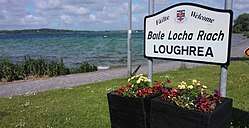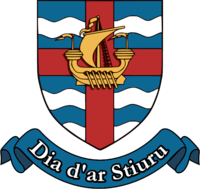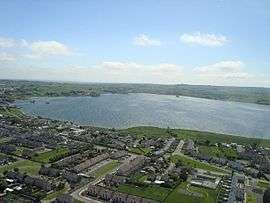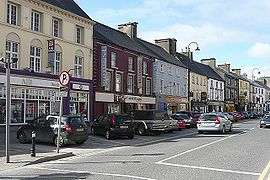Loughrea
Loughrea (/lɒxˈreɪ/ lokh-RAY; Irish: Baile Locha Riach, meaning "town of the grey/ speckled lake") is a town in County Galway, Ireland. The town lies to the north of a range of wooded hills, the Slieve Aughty Mountains, and the lake from which it takes its name. The town's cathedral, St Brendan's, dominates the town's skyline. The town has increased in population in the late 20th and early 21st centuries. Although the town also serves as a commuter town for the city of Galway, it also remains an independent market town.[2]
Loughrea Baile Locha Riach | |
|---|---|
Town | |
 | |
 Coat of arms | |
| Motto(s): | |
 Loughrea Location in Ireland | |
| Coordinates: 53.197°N 8.567°W | |
| Country | Ireland |
| Province | Connacht |
| County | County Galway |
| Elevation | 82 m (269 ft) |
| Population (2016)[1] | |
| • Urban | 5,556 |
| Time zone | UTC±0 (WET) |
| • Summer (DST) | UTC+1 (IST) |
| Eircode routing key | H62 |
| Telephone area code | +353(0)91 |
| Irish Grid Reference | M621163 |
| Website | discoverloughrea |
Name
The town takes its name from Loch Riach (Irish Riach being a variant of 'Riabhach' meaning grey/ speckled)[3] The town is situated on the northern shore of the lake. The lake's Irish name is used in the name of the local Irish-language multi-faith primary school: Gaelscoil Riabhach.[4] The town is located within an area that was historically called Trícha Máenmaige.
History
Pre-Norman
The town is located within an area that was historically called Trícha Máenmaige. This area was under the control of Ui Fhiachrach Fionn, and later by the Uí Maine. The area contains many examples of Gaelic and Early-Christian settlements.
Norman Settlement
The town was founded in 1236 by Richard de Burgo, an Anglo-Norman knight who built a castle along an ancient route between the River Shannon and the west coast. Today the remains of the medieval town wall, medieval priory, moat and a town gate are all still to be seen. The De Burgo family adopted Irish names and customs and assumed the role of chieftains in the following centuries until 1543 when Ulick "Bourck, alias Mac William," surrendered his lands to Henry VIII, receiving it back to hold, by English custom, with his new title, the Earl of Clanricarde. [5]
Pre-Famine
By the 1700s Loughrea was a regional market and garrison town.
Post-Famine
Loughrea was at the centre of the Gaelic Revival towards the end of the nineteenth century. The various elements of this revival in the town included Celtic-Revival Art, the Irish Literary Revival, Gaelic Athletics and the Irish language revival.
Independence
Due to its strong garrison town tradition there was little support for the 1916 rebellion in Dublin, even though some locals supported the local rising in Galway. However, there were Irish Volunteers in Loughrea. They were called the Loughrea Battalion of Irish Volunteers (Loughrea Battalion for short). They didn't do much fighting but they did protect the local Sinn Féin Club members.[6] The leaders of the local Sinn Féin Club were eventually arrested. The results of the 1918 General Election gave victory to Liam Mellows for Sinn Féin in Galway East and saw the defeat of the local Irish Parliamentary Party candidate.
Twentieth-Century
The period from 1920 until 1960 saw Loughrea maintaining its role as a market town. The town is also the cathedral town of the Roman Catholic diocese of Clonfert and the twentieth century saw a number of large scale religious events. The 1960s brought industrial developments such as the development of the Tynagh Mines.
Economy
Loughrea was traditionally a farming town that cut its industrial teeth with the Tynagh mines, 10 km (6.21 mi) to the east. There is now a gas powered electricity power station on the site of the mines. As well as being a dormitory town for Galway, Loughrea now hosts a number of pharmaceutical and data-processing industries. Loughrea's tourist infrastructure is supported by several hotels, a country resort, as well as many bed-and-breakfasts, restaurants, coffee-shops and pubs.
Places of interest
| Year | Pop. | ±% |
|---|---|---|
| 1821 | 5,849 | — |
| 1831 | 6,268 | +7.2% |
| 1841 | 5,458 | −12.9% |
| 1851 | 3,621 | −33.7% |
| 1861 | 3,072 | −15.2% |
| 1871 | 3,072 | +0.0% |
| 1881 | 3,159 | +2.8% |
| 1891 | 2,815 | −10.9% |
| 1901 | 2,557 | −9.2% |
| 1911 | 2,388 | −6.6% |
| 1926 | 2,805 | +17.5% |
| 1936 | 2,891 | +3.1% |
| 1946 | 2,887 | −0.1% |
| 1951 | 2,847 | −1.4% |
| 1956 | 2,834 | −0.5% |
| 1961 | 2,784 | −1.8% |
| 1966 | 3,001 | +7.8% |
| 1971 | 3,075 | +2.5% |
| 1981 | 3,378 | +9.9% |
| 1986 | 3,360 | −0.5% |
| 1991 | 3,271 | −2.6% |
| 1996 | 3,335 | +2.0% |
| 2002 | 4,004 | +20.1% |
| 2006 | 4,532 | +13.2% |
| 2011 | 5,062 | +11.7% |
| 2016 | 5,556 | +9.8% |
| [7][8][9][10][11][1] | ||
The Cathedral of St. Brendan on the lakeshore, in the town centre, is considered an important repository of Celtic-revival art and architecture in Ireland.[12] St. Brendan's Catholic Cathedral was designed by William Byrne in 1897 and completed five years later. Its double transepts are an unusual architectural feature. Spring-fed Loughrea Lake (Lough Rea) is overlooked by Knockash and fished for brown trout, pike and perch.[13] There are also rudd, brook lamprey, three-spined stickleback, nine-spined stickleback and eels in the lake.[14][15] The lake is home to many waterbirds. Migratory species from Europe live at the lake during the winters, and it provides nesting grounds for other species during the summer. The lake is listed as a site of international importance for the shoveller and a site of national importance for the coot and tufted duck.[13] It is also used for water sports and swimming. Immediately behind the Loughrea boathouse are the remains of an old crannog. The Loughrea dwellers of another time would have sought protection from raiders by living in the comparative security provided by the lake.
Transport
Loughrea is connected to the M6 Dublin-Galway motorway via the N65. The town was historically served by the Midland Great Western Railway and a railway branch from Attymon Junction,[16] in use until 1975. This line was Ireland's last operational rural railway branch line, having outlasted most other country railway lines of this type by 10–20 years, and even surviving to have diesel trains used on it. The link road from the Ballinasloe - Galway motorway to Loughrea removed most of the remains of the original track bed. Loughrea railway station opened on 1 December 1890 and finally closed on 3 November 1975.[17]
Sport and culture

Loughrea GAA Club were Galway Senior Hurling Championship the management including Pat O Conner and Mick Kelly and 2006 Connacht Hurling champions. They also reached the 2007 All-Ireland Club Hurling Championship final, losing out to Ballyhale Shamrocks. Loughrea has a rugby club, a soccer club, a Gaelic football club, a volleyball club, an 18-hole golf course, a cycling club and an athletic club. Loughrea cricket club is one of the leading clubs in Connacht. Actor Kiefer Sutherland has an affection for the town, twice visiting family as a young boy and is said to have been amazed at the skill of the players down at the handball alley.
Each year, in October, the town plays host to the BAFFLE International Poetry Festival.[18] Loughrea also boasts a Musical and Dramatic Society, historical society, and a community association. In the 2018 National Glór na nGael awards for "Irish language in local communities", Loughrea's "Gaeilge Locha Riach" was awarded best voluntary committee in Connaught. Gaeilge Locha Riach promotes the Irish language in Loughrea among the community and businesses.[19] There is also a Foróige Youth club in the town.
Each year the Local Triathlon club called Predator organise a junior and senior triathlon event. The race was created by French coach Sebastien Locteau in 2006 with Tony Daly. Loughrea Triathlon is part of the national event calendar under Triathlon Ireland rules.[20]


Annalistic references
- 797(802). The demolition of Loch Riach by Muirghius, son of Tomaltach.
- 821. Fearghal, son of Catharnach, lord of Loch Riach, died.
- 823. Fearghal, son of Cathasach, lord of Loch Riach, died.
- 881. Cormac, son of Ceithearnach, Prior of Tir Da Ghlas and Cluain Fearta Brenainn, and the second lord who was over Loch Riach at that time, died.
- 1408. O'h-Echeidhein was slain by the O'Dalys on the plain of Moinmoy.
See also
- Frederick William Conway
- List of abbeys and priories in Ireland (County Galway)
- List of towns and villages in Ireland
- Marquis de St Ruth
References
- "Sapmap Area - Settlements - Loughrea". Census 2016. CSO. 2016. Retrieved 12 January 2018.
- "Ireland Mid-West Online - County Galway - Towns - Loughrea". www.irelandmidwest.com.
- "meaning of Irish word Riach". www.teanglann.ie.
- "Gaelscoil Riabhach". www.gaelscoilriabhach.ie.
- House of Burke
- "BUREAU OF MILITARY HISTORY (Document)" (PDF).
- Census for post 1821 figures. Archived 2010-09-20 at the Wayback Machine
- "Archived copy". Archived from the original on 7 May 2016. Retrieved 18 March 2020.CS1 maint: archived copy as title (link)
- "Archived copy". Archived from the original on 17 February 2012. Retrieved 28 April 2014.CS1 maint: archived copy as title (link)
- Lee, JJ (1981). "On the accuracy of the Pre-famine Irish censuses". In Goldstrom, J. M.; Clarkson, L. A. (eds.). Irish Population, Economy, and Society: Essays in Honour of the Late K. H. Connell. Oxford, England: Clarendon Press.
- Mokyr, Joel; O Grada, Cormac (November 1984). "New Developments in Irish Population History, 1700-1850". The Economic History Review. Volume. 37 (4): 473–488. doi:10.1111/j.1468-0289.1984.tb00344.x. hdl:10197/1406. Archived from the original on 4 December 2012.
- SchoolsWebsites.ie, Website design and hosting by. "Loughrea Cathedral - Home". loughreacathedral.ie.
- "Loughrea Lake Loughrea County Galway Ireland Loch Riach Loughrea Lough Rea Galway". loughrea.galway-ireland.ie.
- "Loughrea Lake Report" (PDF).
- "Local expert on Loughrea Lake's website".
- Photographs of Attymon Junction to Loughrea railway trackbed Archived 28 September 2007 at the Wayback Machine
- "Loughrea station" (PDF). Railscot - Irish Railways. Retrieved 3 November 2007.
- http://www.bafflepoetry.org
- "Rannta Raifteirí 2019". Gaeilge Locha Riach. Retrieved 24 June 2020.
- http://www.loughreatriathlon.ie/race-history/
External links
| Wikimedia Commons has media related to Loughrea. |
- discoverloughrea.com - Discover Loughrea is your news, entertainment, sport and music website brought to you by Loughrea Chamber of Commerce
- Gaelscoil Riabhach: Loughrea's Gaelscoil
- Tourist Information for Loughrea: Provides information on Loughrea's attractions, activities and businesses.
- Gaeilge Locha Riach
- Loughrea Foróige
- THE LEAVING OF LOUGHREA - An Irish family in the Great Famine by Stephen Lally
